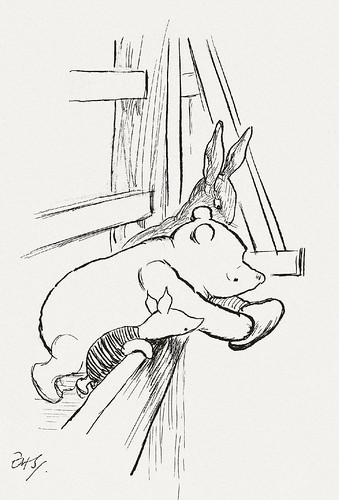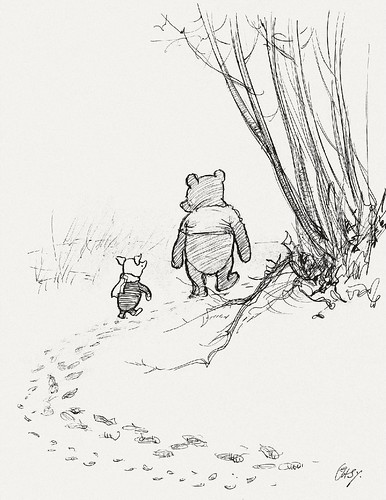According to BibliOdyssey forty two original E.H. Shepard illustrations will be auctioned at Sotheby’s (New Bond Street, London) on 17th of December.
These are among my favourite illustrations of all time, matched only by my love of the stories they accompany. I spent many hours reading these stories to my children and never grew tired of Milne’s humour and beautiful language. It is hard to imagine the stories without these wonderful illustrations which inspired, but were never matched by, Disney.

This quote from peacay. He mentions on his blog that these images may be protected by copyright and that he will remove them if requested. As I have linked to him, they would then disappear from here too, ah well.
Ernest Howard Shepard (1879-1976) was born in London and encouraged to draw from a young age by his artist mother. He won a scholarship to the Royal Academy at the age of eighteen.
In the early years of the 20th century Shepard achieved some success with illustrated editions of Dickens and Aesop’s fables. By 1907, Punch Magazine had accepted some of his drawings for publication although he wasn’t a permanent Punch employee until 1921. He would remain there for more than thirty years.
In WWI, Shepard earned a Military Cross for bravery during service with the Royal Artillery in France and Belgium but he continued to sketch humorous vignettes which he submitted to Punch. In the 1920s, he was introduced to Alan (AA) Milne who reluctantly commissioned Shepard to do some line drawings for a children’s book he had written. And the rest, as they say, is history.
Shepard and Milne were never particularly close but their collaboration on the four books – ‘When We Were Very Young’ (1924); ‘Winnie the Pooh’ (1926); ‘Now We Are Six’ (1927) and ‘The House at Pooh Corner’ (1928) – ensured that their names would be associated for eternity. Characters included Christopher Robin, Winnie the Pooh, Tigger, Eeyore, Piglet, Owl, Rabbit and Kanga.
The character of Winnie the Pooh was based on Milne’s son’s (Christopher) teddy bear, but the drawings were inspired by a toy bear named Growler, belonging to Shepard’s own son. Growler would be mauled to death by a neighbour’s dog, but Christopher’s bear (and other stuffed Winnie the Pooh animals) circuitously made their way to the New York Public Library where I believe they still live. Late in life, Shepard was said to have voiced some resentment that the “silly old bear” had overshadowed his other illustration work, but he had expressed his fondness for the characters on many more occasions, so this phrase may have been more affectionate than has been reported*.
Although he pursued book and magazine illustration all through his life, Shepard’s most notable work, beyond the AA Milne quartet, were the line drawings he produced for Kenneth Grahame’s ‘The Wind in the Willows’, published in 1931.